The Google Nest Hub's sleep features are dream-worthy
Its contactless sleep tracking is more accurate than any other device I've tried.
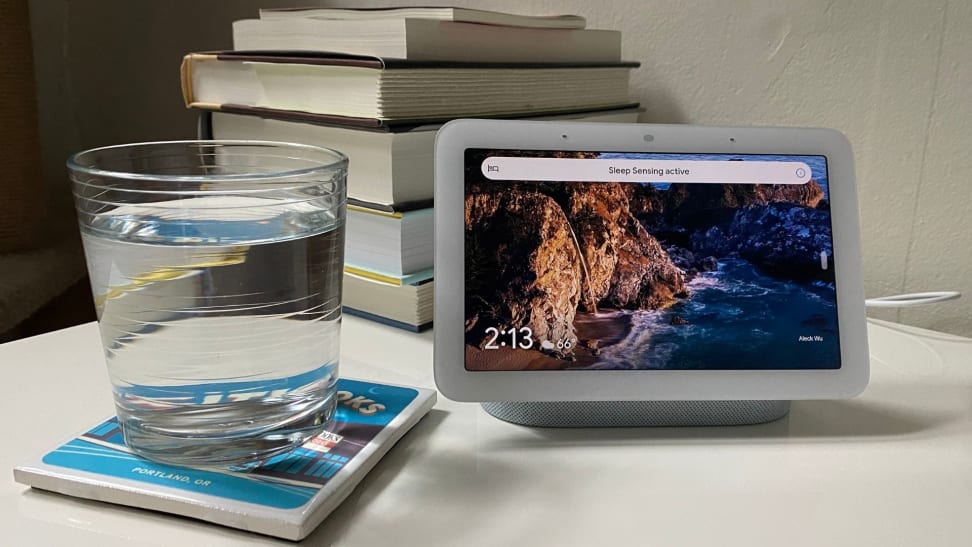 Credit:
Reviewed / Lindsey Vickers
Credit:
Reviewed / Lindsey Vickers
Products are chosen independently by our editors. Purchases made through our links may earn us a commission.
Whether you already have a smart home or are just dipping your toes into automating your lights, entertainment, shopping lists, and so on, you’re probably aware of Google’s position as a leader in the field. The tech giant released its first smart home device in 2016, and subsequent offerings include features that aim to give users more bang for their buck.
Among the more noteworthy new features of Google’s newest smart display, the Nest Hub Second Generation, is Sleep Sensing. When placed on your bedside table, the Hub claims to collect insights into your sleep patterns and habits through passive tracking (think: no chunky wearable you have to keep strapped to your wrist overnight). In fact, you don’t have to activate it at night, or charge it like a Fitbit or Apple Watch—the idea is that you just plug it in and let it do its thing.
As the sleep writer I was skeptical. Every sleep tracker I’ve used gets one part or another of my nightly patterns and routines totally wrong. And, as a device that falls into the “smart display” category, I was extra dubious of the Google Nest Hub’s sleep sensing capabilities—how well could it possibly work at capturing a biological process without physically touching you? But low expectations are the breeding ground for surprise, and that’s just how I felt after using the Nest Hub to track my sleep for a few weeks.
What is the Google Nest Hub (second generation)?
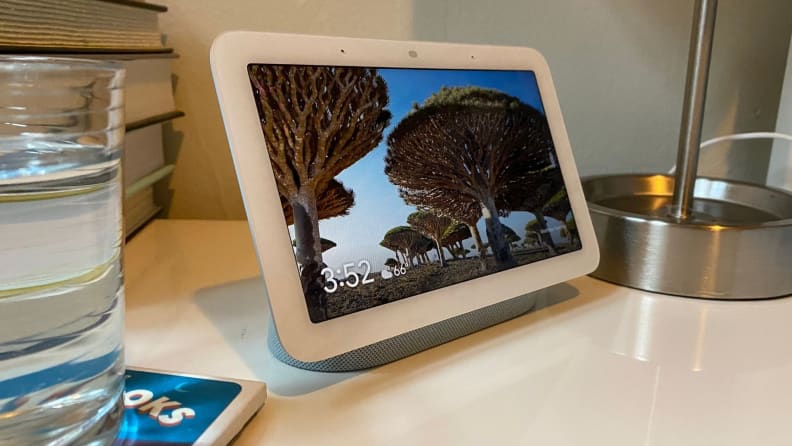
The Nest Hub is a small smart display that can be used beside your bed for sleep tracking.
This smart display has a 7-inch touch screen that looks not unlike a digital photo frame. In fact, that’s what it automatically operates as: The screen cycles through photos during the day, and displays a dimly lit digital clock at night. (You can turn this feature off or use it with personal photos as well.) It adjusts to ambient settings and lighting—when you go to bed, for example, it registers that the room is dark and automatically switches to a dimmed, photo-less clock display.
Of course, the display comes with all the other smart home perks. It serves as a hub for Google Assistant and as a voice-controlled speaker. You can ask it for the weather, have it interpret other languages, and link to your Spotify account to play music, as well as sync it with other compatible devices allowing you to, say, lock the door, check out live video from security cameras, control the TV, turn on and off smart plugs, and so on.
But its nighttime features are what I’m here to discuss—and if you ask me, that’s when it really shines (obviously not in a literal sense) as a smart device that analyzes your sleep.
How does the Nest Hub track sleep?

Sleep Sensing gathers data through a radar system in the Nest Hub.
The Nest Hub’s Sleep Sensing relies on a miniature radar called “Soli” to recognize when you’ve gone to bed and collect data on your movement throughout the night. It also uses microphones to gather audio, which is analyzed for respiratory changes, like coughing or snoring, that indicate sleep interruptions you might not be aware of. I wasn’t able to find other devices that use radar to track your sleep—though there are murmurs that a similar radar-based technology may be introduced to Alexa products soon.
When Google developed the device, and Sleep Sensing in particular, it compared its data to a polysomnogram sleep study of 33 healthy sleepers (people who don’t have significant issues like sleep apnea or insomnia). As with diagnostic polysomnography, the tech company measured participants’ breathing patterns, brain waves, movement, and blood oxygen levels, among other things. Board-certified sleep technologists then independently annotated each participant’s sleep data and established a “groundtruth.” Google compared this groundtruth sleep data to the Nest Hub’s algorithm. This research-driven approach is likely why users, like me, may find it accurate.
What are the Google Nest Hub’s sleep features?
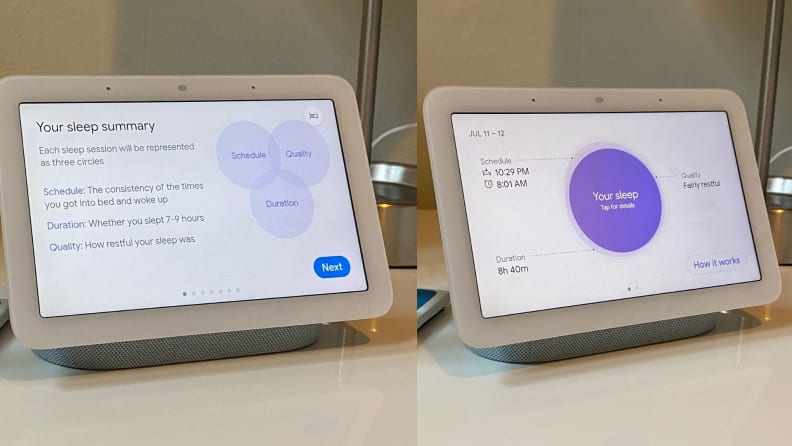
Your sleep data is displayed as three more or less conentric circles.
If you use the Nest Hub as your wake-up call, you can check out its analysis of your sleep right after you dismiss the alarm. Many other sleep trackers provide an overload of information that sometimes isn’t even helpful. The Nest Hub parses it down to the basics, with a graphic that’s easy to understand at a quick glance. The display uses three overlapping circles (similar in appearance to a Venn diagram) to illustrate your schedule, sleep duration, and rest quality.
Duration and schedule are fairly objective. When you set up the Nest Hub, you enter target bedtimes via the Google Health app, and duration is simply how long you slept. What’s trickier to understand is sleep quality. According to Google, it evaluates this metric based largely on your movement and breathing patterns, which are tracked via radar. The three circles will be more closely aligned if your sleep quality is higher—and less concentric if it's suffering.
What we like about Sleep Sensing on the Nest Hub
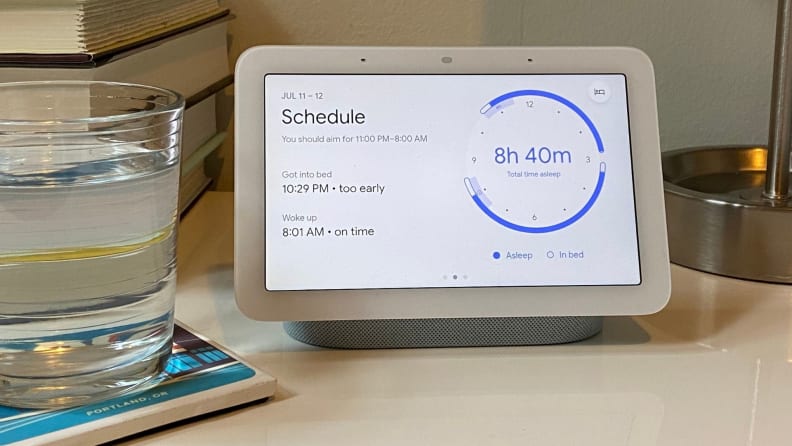
The Nest Hub is the only sleep tracking device that's detected exactly when I go to bed and fall asleep.
It’s stunningly accurate
I’ve used a lot of sleep trackers at this point—from the Fitbit Sense to Tempur-Pedic’s Sleep Tracker. After looking at the data from those devices night after night, I realized that I’m really good at seeming like I’m asleep. My heart and respiratory rate must drop when I lie down in bed and watch Netflix or browse on my phone, because every tracker I’ve used thought I was asleep far earlier than I actually was—that was until I used the Google Nest Hub. (Yes, there’s a lot of room for improvement when it comes to my sleep hygiene.)
I don’t know how its radar does it, but the Google Nest Hub never failed to accurately pinpoint when I got into bed, as opposed to when I actually went to sleep.
It has other sleep-friendly features
A while back, I tested the Hatch Restore—a sunrise alarm that’s other selling point is helping you create and maintain a nighttime routine. Spoiler alert: I didn’t hate it, but I didn’t love it, either. In contrast, I looked forward to saying goodnight to the Google Nest Hub each evening.
The Google Nest Hub isn’t specifically designed for nightly routines, but somehow that was one of the features I loved most. When I set it up, the Nest Hub asked what I would like to do each night after I activated the device by saying “OK Google, goodnight.” I set it up to tell me the weather forecast for the following day, ask what time I’d like to wake up, and tell me if my phone’s battery was below 25% (though I quickly learned this feature doesn’t work with iPhones).
After getting through the housekeeping, the Nest Hub says “goodnight” and starts playing the white noise track that's pre-determined via the app. I selected the “country sounds,” which lulled me to sleep with chirping crickets—I suppose that having grown up in Utah, I’m a country bumpkin at heart. If you want a gadget to give you a longer and delineated nighttime routine, the Hatch Restore is the way to go. However, if you would rather a shorter nighttime routine that lasts for less than a couple minutes, but still gives your bedtime wind down a bit of structure, the Nest Hub is where it’s at.
What we don't like about the Nest Hub’s Sleep Sensing
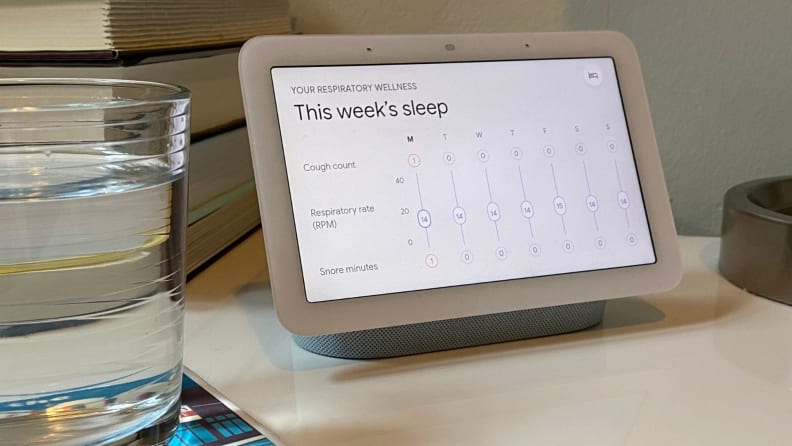
One of the biggest downsides is Sleep Sensing won't be free indefinitely.
It’s not free
Folks who purchase the Nest Hub this year will receive a free trial of the Sleep Sensing feature that will last through next year. Google might be transparent about data, but it’s not as clear on what the Sleep Sensing feature will cost following the preview period. If it’s anything like the Fitbit sleep tracking, which only comes with premium subscription, you could be into it for more than $75 per year. Of course, it’s speculation at this point as the company has yet to release specifics.
It’s only designed to track one person’s sleep
Google says the Nest Hub is only designed for one person’s sleep. If you have a partner who snores loudly beside you, the Nest Hub will probably register their snores as your own. (I can’t imagine how it wouldn’t.)
On the upside, it’s other features rely on motion sensing. I’d be surprised if the motion sensing is thrown by another person in the bed—as long as the device is oriented correctly—but seeing as I used it as a solo sleeper, I can’t be sure.
It doesn’t provide tons of details
If you want more information on specifics, such as your heart rate overnight, you’ll be better off opting for a wearable tracker. The Google Nest Hub provides a great deal of accurate data, especially for a contactless device. I liked the metrics it collected and analyzed—but if you’re looking for more detailed information you’ll be better off opting for something else.
Setup is a hassle
I assumed that the device would automatically track my sleep. Google, however, further proved its cognizance of user privacy by making it annoyingly difficult to set up Sleep Sensing. You have to enable sleep tracking through the connected Google account. On the app, I gave the Nest Hub permission to collect data on my sleep and assumed that I was good to go. Alas, the device also needed to be calibrated. Fortunately, that part was easy. It took a matter of minutes and the device had clear prompts walking me through each step.
What are the privacy features of Nest Hub’s Sleep Sensing?
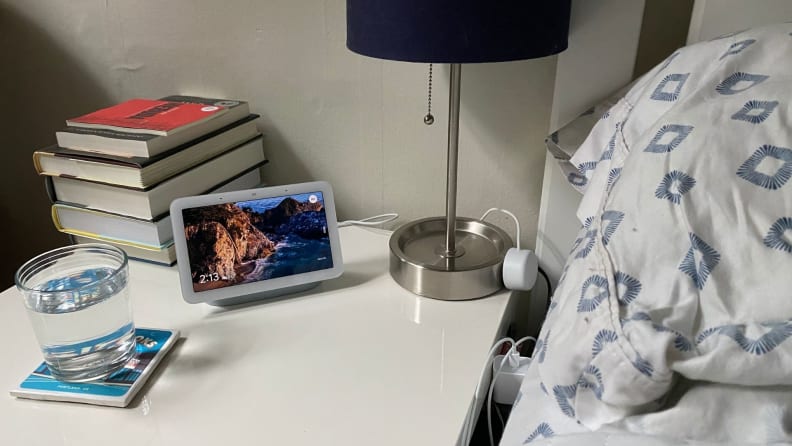
The Nest Hub has a number of privacy features that put me at ease.
As with any smart home device, privacy is a major concern. Google is pretty transparent about how data on the Nest Hub is used, and whether it’s shared with the company. (I’m looking at you, Amazon, for opting everyone into things like Amazon Sidewalk.) According to Google, audio collected and analyzed by the device for Sleep Sensing stays local, as it’s processed on your device and never sent to the company or stored.
One of the other privacy-oriented features that I appreciated: The Nest Hub doesn’t rely on a camera to monitor you. There’s just something weird about the notion of a device sitting there and, quite literally, watching you while you sleep. Sleep Sensing is purely based on audio and radar data, so you don’t have to worry about switching a camera on and off every time you get dressed, or anything like that.
In addition, there’s an easy-to-use button on the back that allows you to turn the microphone on and off, in case there are, er, certain bedroom activities you don’t want Google to have any information on. (Also the Sleep Sensing is extremely sensitive, even when I so much as briefly sit on my bed to put on shoes, it’s activated. In other words, it knows when you’re on the bed, regardless of what you’re doing.)
Would I recommend the Nest Hub for sleep tracking?
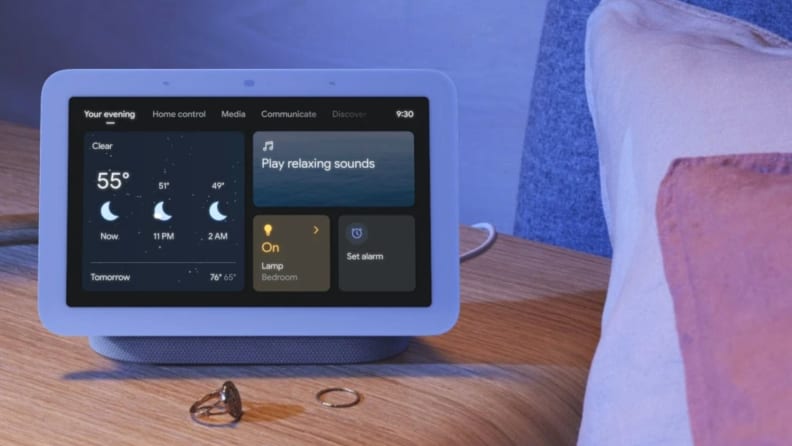
I loved using the Nest Hub to track my sleep.
I’m surprised by the accuracy and capability of the Nest Hub, which is saying something, as when it comes to sleep sensing and tracking, my bad experiences outnumber the good ones.
The Nest Hub was the exception to every rule, in my experience. It was more accurate—if less detailed—than most of the other sleep trackers I’ve used. For example, it doesn’t show when you’re in each sleep stage the way that Fitbit does. But I prefer the accuracy I saw from the Nest Hub, as opposed to an overload of information I know isn’t true (having to adjust the time you fell asleep in the Fitbit app night after night gets old).
As a bonus, the device has the option for users to create a short and sweet nighttime routine, and set their alarm with voice only. I loved that part of using the Google Nest Hub in my sleep routine. The automatic dimming of the display at night also makes it sleep-friendly.
I have an Alexa smart speaker and smart plug, so venturing into the Google realm sounded like a headache. But as my time with the Nest Hub came to a close, I considered buying one. When I found out it retails for just under $100, I was shocked—the device has a lot to offer, especially byway of sleep tracking, for that price. (That’s not considering it sometimes goes on sale. Around the time this was written, it had dropped to just $79.99 at Best Buy.)
Though I haven’t splurged and bought a Nest Hub for myself yet, I wouldn’t say it’s off the table. If you haven’t invested one way or another in the smart home realm, I’d absolutely recommend looking into the Google Nest Hub. You shouldn’t expect its sleep features to totally change your life, but you can look forward to them teaching you more about your sleep and providing accurate insights with minimal intrusion and hassle once the device is up and running.
